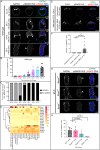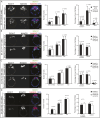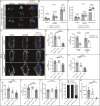Smad4 is essential for epiblast scaling and morphogenesis after implantation, but nonessential before implantation
- PMID: 38752427
- PMCID: PMC11190579
- DOI: 10.1242/dev.202377
Smad4 is essential for epiblast scaling and morphogenesis after implantation, but nonessential before implantation
Abstract
Bone morphogenic protein (BMP) signaling plays an essential and highly conserved role in embryo axial patterning in animal species. However, in mammalian embryos, which develop inside the mother, early development includes a preimplantation stage, which does not occur in externally developing embryos. During preimplantation, the epiblast is segregated from extra-embryonic lineages that enable implantation and development in utero. Yet, the requirement for BMP signaling is imprecisely defined in mouse early embryos. Here, we show that, in contrast to previous reports, BMP signaling (SMAD1/5/9 phosphorylation) is not detectable until implantation when it is detected in the primitive endoderm - an extra-embryonic lineage. Moreover, preimplantation development appears to be normal following deletion of maternal and zygotic Smad4, an essential effector of canonical BMP signaling. In fact, mice lacking maternal Smad4 are viable. Finally, we uncover a new requirement for zygotic Smad4 in epiblast scaling and cavitation immediately after implantation, via a mechanism involving FGFR/ERK attenuation. Altogether, our results demonstrate no role for BMP4/SMAD4 in the first lineage decisions during mouse development. Rather, multi-pathway signaling among embryonic and extra-embryonic cell types drives epiblast morphogenesis postimplantation.
Keywords: Epiblast; Extra-embryonic; Maternal and zygotic gene deletion; Morphogenesis; Mouse; PSMAD1/5/9.
© 2024. Published by The Company of Biologists Ltd.
Conflict of interest statement
Competing interests The authors declare no competing or financial interests.
Figures





Update of
-
Smad4 is essential for epiblast scaling and morphogenesis after implantation, but nonessential prior to implantation in the mouse.bioRxiv [Preprint]. 2024 Jan 24:2024.01.23.576717. doi: 10.1101/2024.01.23.576717. bioRxiv. 2024. Update in: Development. 2024 Jun 1;151(11):dev202377. doi: 10.1242/dev.202377. PMID: 38328075 Free PMC article. Updated. Preprint.
References
-
- Boroviak, T., Loos, R., Lombard, P., Okahara, J., Behr, R., Sasaki, E., Nichols, J., Smith, A. and Bertone, P. (2015). Lineage-specific profiling delineates the emergence and progression of naive pluripotency in mammalian embryogenesis. Dev. Cell 35, 366-382. 10.1016/j.devcel.2015.10.011 - DOI - PMC - PubMed
MeSH terms
Substances
Grants and funding
LinkOut - more resources
Full Text Sources
Molecular Biology Databases
Miscellaneous

